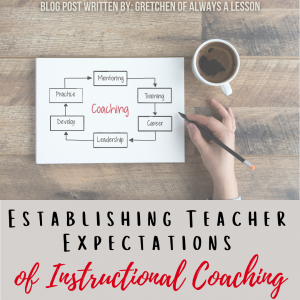Establishing Teacher Expectations of Instructional Coaching
Are there clear teacher expectations of what instructional coaching looks like at your school site? If not, you’re not alone. Many schools do not define, share nor uphold expectations for the role of an instructional coach. This does a disservice to teachers who have access to a support but no idea how to utilize it. This post will help you establish teacher expectations of instructional coaching for your building.
Set
If you have never had an instructional coach at your school site, then you probably have no idea what one does and how to leverage the role to better the performance of teachers and students. Or if you have an instructional coach at your school site but are unclear as to what they do, it might mean they wear too many hats and perform too many unrelated duties.
These misconceptions of who a coach is, what they do and how to utilize one sets a school up for failure. (Grab this Coach’s Duties Pie Chart to see where a coach should be spending their time.)
An instructional coach is a pivotal piece to increasing student achievement and teacher proficiency. One way to combat this is make it very clear WHO all the stakeholders are and WHAT their role is. (Grab a copy of Teachers Level of Support- Roles and Duties and Teacher/Coach Role Descriptors to help you.)
Below are steps to set up instructional coaching at your school site:
-
- Set the foundation by assigning the instructional coaching role to a teacher leader
- Set the expectations for the role:
-
- What will they do?
- How will they do it?
- How will you know they did it and did it well?
-
- Share these expectations with teachers so that all stakeholders are on the same page.
- Design a menu of services (like this one) so teachers and choose how to work together
- Share at a staff meeting or at a “Meet the Coach” event
- It’s important that teachers know an instructional coach is to support all teachers, not just ones that are struggling, new or willing to work together. When the school embraces the idea of a continuous improvement model, instructional coaches can benefit everyone. The role is not designed as a “gotcha” or to dictate next steps.
[bctt tweet=”An instructional coach is a guide to help teachers think through their obstacles, not feed them the answers. It is not an top-down initiative with a hierarchy of power. It is a partnership that happens with teachers.” username=”gschultek”]
Remind
Once the expectations of a coach are established, it’s important to remind staff about these expectations on a consistent basis. This way they do not forget what support is available to them and how they can receive it. Even though teachers were made aware of the role of an instructional coach, it may take numerous attempts before they are ready to take a coach up on their offer. The goal is to move from teacher-coach communication to a teacher-coach working relationship.
Remind staff of who the coach is, how to reach them, and how they can partner together. This can be done in an email, monthly newsletters, and ongoing professional development. You might feel like a broken record, but reminders keep the idea front and center and increase the likelihood teachers will reach out for help.
Recalibrate
When instructional coaches are working 1:1 or in a small group of similar grade level or content area teachers, they are able to recalibrate the expectations for their role. They should listen to the needs of the teachers, share a variety of ways in which they can help, and then revise their role to meet those needs.
Sometimes teachers and instructional coaches are not on the same page as to what the support options should look like. This leads to dishonesty, lack of collaboration, negative talk, frustration, and a stagnation in teacher and student growth.
Recalibration ensures expectations are clear, all voices are heard, and teachers are receiving the support they need when they need it. Flexibility is key!
When the expectations of an instructional coach are clearly set, shared and recalibrated on an ongoing basis, teachers will receive the support they need and desire. This support will allow teachers to increase their own instructional skillset while enhancing the learning outcomes of their students.
If you want to read more about instructional coaching, check out this blog post that outlines all of my professional book recommendations. If you need additional printable forms to support your coaching role with teachers, grab the bundle of over 300 pages here.
GO BE GREAT!
How do you establish teacher expectations of instructional coaching at your school?


